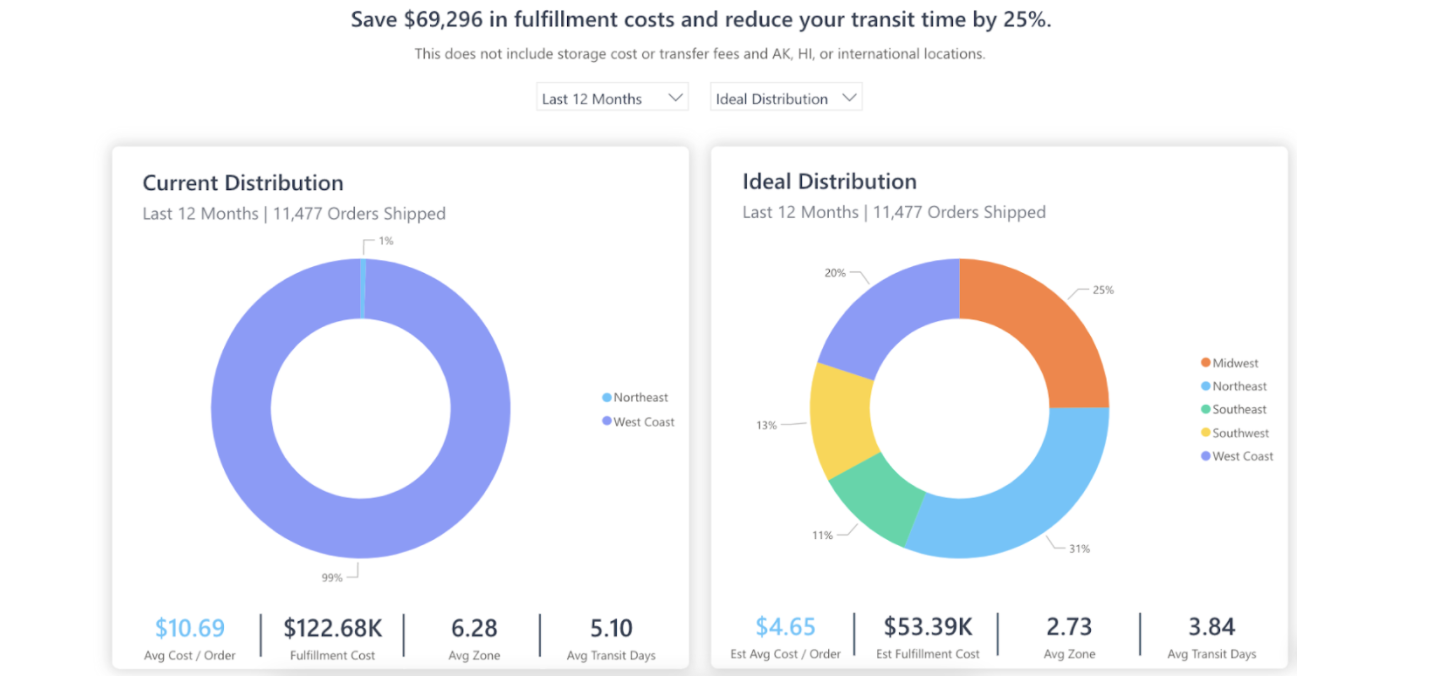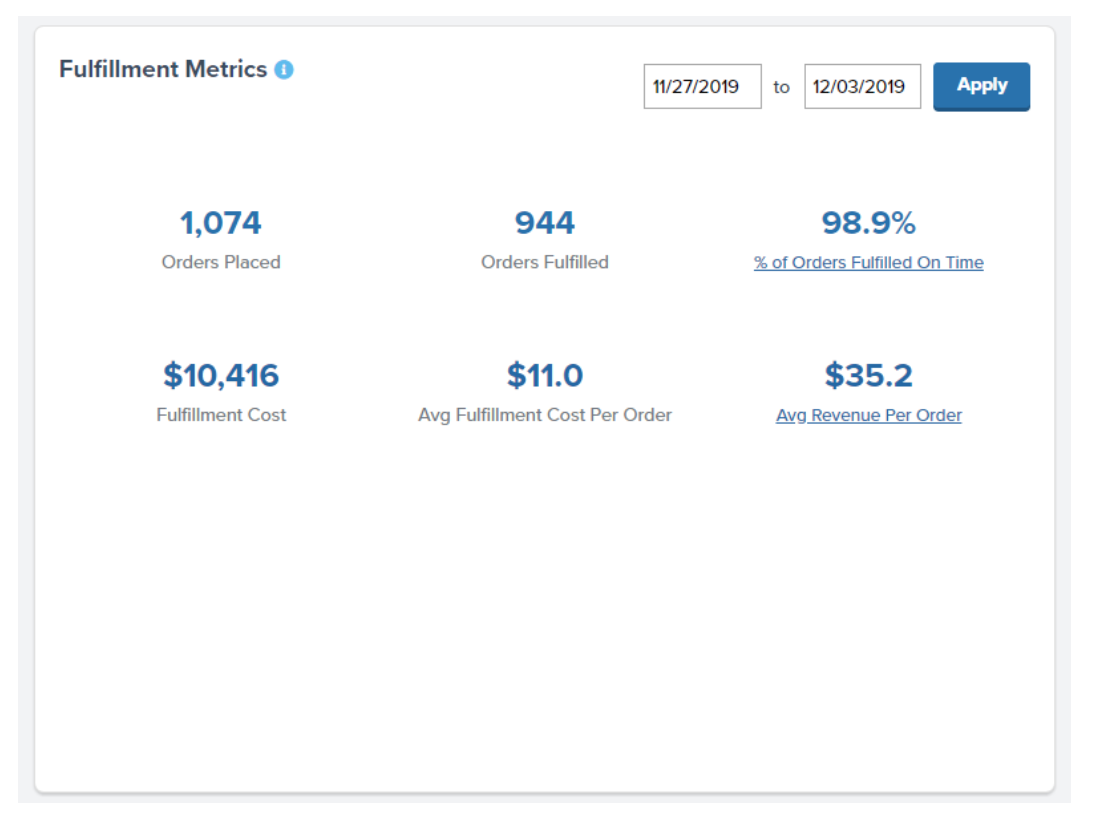Table of Contents
** Minutes
Analytics: The secret weapon for top ecommerce brands
Why analytics are often ignored or underutilized in ecommerce
Top ecommerce metrics to analyze
Top ecommerce analytics tools every site needs
How ShipBob gives their customers a competitive advantage with their analytics – for free
When you’re going on a road trip, you’re likely going to prepare for your journey with a detailed map to ensure you get where you’re going, don’t make any wrong turns, and arrive at your destination quickly and efficiently.
The same goes for your business. Accurate analytics can be the roadmap to your business’s success.
Knowing how your business is currently performing is critical for every ecommerce retailer. Otherwise, you won’t know whether your existing strategies and processes are working or if your financial investments are yielding sufficient returns. That also means you won’t know if and when you’re doing something wrong or what you need to fix to improve your numbers.
That’s why ecommerce analytics are vital if you want your DTC brand to grow. In this post, we’ll help you identify the key metrics and key performance indicators you need to track in ecommerce analytics and the best tools that will help you gain a competitive edge.
What is ecommerce analytics?
Ecommerce analytics refer to the process of collecting and analyzing data relating to different aspects of your ecommerce operations. This includes everything from marketing and sales to website engagement to fulfillment and logistics. The goal is to discover meaningful insights about trends, business performance, backend processes, and online consumer behavior so you can make data-driven decisions based on those insights.
Analytics: The secret weapon for top ecommerce brands
Brands can use ecommerce analytics to derive valuable, actionable insights about their business and operations. From identifying gaps in their existing processes to better understanding their customers, there’s a lot that business owners can gain from analyzing the data that’s collected. These insights can better inform different aspects of their business to facilitate growth as well as enhance customer experiences.
Deliver data-driven strategies
From marketing to website design to inventory stocking – analyzing data helps DTC brands create data-driven strategies. Ecommerce analytics can tell you which marketing strategies resonate with the audience, where user drop-offs happen on your website, and how much inventory would be enough and when. All of those insights will tell you how to strategically make decisions that will help you in the long run.
Utilizing ecommerce analytics takes the guesswork out of your strategies so you can flawlessly execute plans that will have a positive impact.
Understand and meet consumer expectations
Are people more likely to buy your products after interacting with a live chat agent? Do they tend to shop more for a certain product at a particular time of year? Are there reviews pointing out a common unsatisfactory experience?
Ecommerce analytics allows brands to collect answers to those questions and understand how they can make improvements according to customer behaviors, preferences, and demands.
Optimize marketing and sales campaigns
Ecommerce analytics can help you understand how customers find you so you can capitalize on the most profitable channels. You can also understand the kind of messaging that works best on your target audience, which will allow you to optimize your advertising campaigns for greater impact.
Reduce supply chain & fulfillment costs
Ecommerce analytics can also alert you where bottlenecks in the supply chain are happening and how you can make the entire process more efficient to not only improve fulfillment speed but also reduce cost. You can use it to identify any steps in the process that might be costing much more than they should so you can investigate and optimize as needed.
Why analytics are often ignored or underutilized in ecommerce
While analytics are important, they’re often overlooked or ignored in ecommerce because of how complicated they can be. Ecommerce operations involve a lot of moving parts and there are a lot of things to track across different departments and processes. Collecting and analyzing data from third-party vendors and switching between multiple platforms for metrics and analytics can be challenging.
The inability to get a single dashboard from where you can keep track of every single aspect of your ecommerce operations makes the job extremely challenging. That’s why many ecommerce businesses may limit their analytics to just a few aspects of their processes and have trouble extracting insights that can turn into action. One of the solutions to overcome the complexity and challenges in collecting and analyzing data in ecommerce is the use of a self-service reporting tool. With self-service reporting tools, ecommerce business owners and managers can easily generate reports on key performance indicators such as website traffic, conversion rates, average order value, and customer retention.
Top ecommerce metrics to analyze
Since there are so many metrics that you can track with ecommerce analytics, it’s important to narrow your focus on the metrics that matter most. This may vary depending on the unique goals of your business and may change according to your campaign.
Campaign-wise metrics aside, these are some of the most important ecommerce metrics that businesses will typically need to track to conduct their analytics:
- Conversion rate
- Cart abandonment rate
- Site traffic
- Bounce rate
- Scroll depth
- Exit rate
- Drop-off points
- Traffic source/medium
- Demographics
- Location
- Return on ad spend (ROA)
- Revenue per visitor
- Cost per acquisition
- Projected revenue
- Average order value
- Ad reach and impressions
- Email click-through rate
- SKU performance
- Average shipping time
- Average fulfillment time
- Average storage cost per unit
- Average fulfillment cost per unit
- Average shipping cost
- Inventory turnover rate
- Order accuracy rate
- On-time fulfillment
- Revenue and profit
- Customer lifetime value
- Churn rate
- Retention rate
- Refund and return rate
- Net promoter score (NPS)
Website & engagement metrics
It’s important to track metrics that measure your website performance and how customers are engaging with it. You can use this to identify any issues in your web design or positioning and where you should make improvements to drive more engagement.
| Metric | What This Measures | Analytics Tools |
| Conversion Rate | Percentage of visitors who end up converting i.e. performing the desired action such as buying something or becoming a subscriber | Google Analytics, Woopra, Matomo |
| Cart Abandonment Rate | Percentage of visitors who add items to their cart without completing their purchase | Google Analytics, Matomo |
| Site traffic | The total number of visitors coming to your ecommerce website | Google Analytics, Woopra |
| Bounce rate | Percentage of visitors who leave a page without performing the desired action | Google Analytics, Matomo, Woopra |
| Scroll depth | How far visitors are scrolling down each page on your ecommerce site | Hotjar, Matomo, Woopra |
| Exit Rate | Percentage of people leaving your website from a particular page | Google Analytics, Matomo, Woopra |
| Drop-off points | Where visitors are dropping off your page | Hotjar, Matomo |
Marketing & sales metrics
These metrics help you measure the effectiveness of your marketing campaigns and your current sales performance. Analyzing your marketing and sales metrics can provide you with the insights you need to refine your targeting and your campaign messaging.
| Metric | What This Measures | Analytics Tools |
| Traffic source/medium | Which channels and platforms your traffic is coming from | Google Analytics, Matomo, Ruler Analytics |
| Demographics | The gender and age distribution of your visitors | Google Analytics |
| Location | The geographic locations of your visitors | Google Analytics, Matomo |
| Return on ad spend (ROAS) | How much revenue you earn for every dollar you spend on advertising | Ruler Analytics, Crealytics, BeProfit |
| Revenue per visitor | Average amount of revenue generated for each visit to your website | Google Analytics |
| Revenue per order | Average amount of revenue generated on each order placed on your website | ShipBob |
| Cost per acquisition (CPA) | How much it costs to get a customer to take a certain action | Native ad analytics tools, Ruler Analytics |
| Average order value (AOV) | Average dollar amount that each customer spends when placing an order on your website | Enhanced Ecommerce from Google Analytics, REVEAL |
| Ad reach & impressions | The total number of people your ad managed to reach and the total number of times people saw your ad | Native ad analytics tools |
| Email click-through rate (CTR) | Percentage of recipients who clicked on a link in your email | MailTag |
Inventory & fulfillment metrics
These metrics give you an idea of how the warehousing and fulfillment aspects of your ecommerce operations are performing. They help you detect any inefficiency in the process and how you can make improvements to streamline fulfillment and improve delivery experiences for your customers.
| Metric | What This Measures | Analytics Tools |
| SKU Performance | Number of units sold for each SKU during a certain period and how it compares to the previous period | ShipBoB |
| Average shipping time/Average transit time | Average time taken by shipping carriers to deliver orders to the final destination | ShipBoB |
| Average fulfillment time | Average time taken to deliver orders after they’re placed on your website | ShipBoB |
| Average storage cost per unit | How much it costs on average to store each unit in your inventory. Calculated by dividing total warehousing cost by average units on hand | ShipBoB |
| Average fulfillment cost per order | How much it costs on average to fulfill each order. It factors in the cost to receive and store inventory, process orders, and pick, pack, and deliver them | ShipBoB |
| Average shipping cost | How much it costs on average to ship out your orders and have them delivered to the final destination | ShipBoB |
| Inventory turnover rate | The number of times inventory gets sold and then replenished during a specific time period | ShipBoB |
| Order accuracy rate | Percentage of orders that you manage to deliver without errors | ShipBoB |
| On-time fulfillment | Percentage of orders that you fulfill on time | ShipBoB |
Bonus business metrics
Beyond these category-specific metrics, there are several other metrics that are essential to measure. These will provide you with greater insights into how your ecommerce business is performing, especially when it comes to satisfying and retaining your customers.
| Metric | What This Measures | Analytics Tools |
| Revenue & profit | Total income generated from selling your products and the income that remains after deducting expenses | Enhanced Ecommerce from Google Analytics, BeProfit, REVEAL |
| Customer Lifetime Value (LTV) | Average revenue that your business can generate from a customer over time | REVEAL, Crealytics, BeProfit |
| Churn rate | The number of customers your business loses over a certain period of time | Crealytics |
| Retention rate | Percentage of customers your business retains over a certain period of time | REVEAL |
| Refund & return rate | Percentage of orders you have to issue a refund for and the percentage of orders that were returned by the customer | Google Analytics, ReturnLogic |
| Net Promoter Score (NPS) | The likelihood of customers recommending your brand to others | REVEAL |
Top ecommerce analytics tools every site needs
Manually keeping track of all these metrics can be challenging, if not impossible. Fortunately, there are several ecommerce website analytics tools that can automatically collect the data and process it to give you the insights you need.
| Tool | Features | Pricing |
| Google Analytics | Site performance tracking, conversion tracking | Free |
| Hotjar | Heatmap tracking, behavior analytics | Free with paid plans starting at $39/mo. |
| Woopra | Customer journey analytics, product analytics | Free with paid plans starting at $349/mo. |
| Matomo | Site performance tracking, conversion tracking, visitor profiles | Starts at $9/mo. |
| Ruler Analytics | Customer journey analytics, marketing attribution | Starts at $149/mo. |
| Crealytics | ROI tracking, CLV measurement | On request |
| REVEAL | Customer analytics, product analytics | Free with paid plans starting at $99/mo. |
| MailTag | Email analytics | Starts at $12.99/mo. |
| BeProfit | Profit analytics | Free with paid plans starting at $20/mo. |
| ReturnLogic | Return analytics with SKU-level insights | Starts at $300/mo. |
| ShipBob | Fulfillment and logistics tracking, inventory tracking | Free for ShipBob customers |
| Bonus: Enhanced Ecommerce from Google Analytics | Comprehensive ecommerce analytics | Free |
Google Analytics
Google Analytics is a free tool that provides you with a detailed breakdown of your website performance. It helps you keep track of your site traffic and breaks them down by source, demographics, and geo-location. It also provides you with insights into your conversions, abandonment rates, and refunds to get a comprehensive view of your store performance.
Hotjar
This heatmap tracking tool helps you analyze how users are behaving on your site so you can see what they’re engaging with, where their attention drops, and how your optimization efforts change their behavior.
Woopra
Woopra allows you to visualize how visitors move through your website and how different products and marketing campaigns influence their behavior. It provides you with a detailed breakdown of where visitors are dropping off in the journey and how many users you’re converting from AdWords.
Matomo
A powerful alternative to Google Analytics, Matomo provides you with comprehensive insights into your website performance. Beyond the analytics that you get with GA, it also comes with conversion optimization features including heatmaps, A/B testing, and form analytics. Plus, you even get to review all the actions taken by individual users on your site.
Ruler Analytics
This comprehensive analytics solution integrates with your website, CRM, and other marketing apps to automatically generate accurate insights into your sales and revenue. It lets you measure the performance of different marketing channels by revenue and leads generated and comparing it to cost, so you can analyze ROAS and CPA for each revenue source.
Crealytics
The Crealytics CLV Platform lets you accurately measure the value of your customers with detailed insights into customer lifetime value, order margins, and retention costs. It also gives you an idea of how your advertising efforts are paying off with ROAS insights and a channel-wise breakdown of churn rate.
REVEAL
A comprehensive ecommerce analytics platform, REVEAL by Omniconvert lets you track metrics like revenue, margin, number of customers, AOV, and average order per customer. You can also understand customer-centric performance insights with CLV, NPS, and retention rate data.
MailTag
MailTag is an email tool that provides you with advanced insights into your email performance. It shows you details like average open rate and link click rate so you can understand the effectiveness of your email campaigns.
BeProfit
Available for Shopify and Wix users, BeProfit allows you to accurately measure your ecommerce profits. It pulls data on your expenses, marketing performance, CLV, platform-wise conversions, and ROAS to give you precise profit analysis and identify your most profitable products.
ReturnLogic
This tool provides you with SKU-level insights into your returns, helping you understand return rates and revenue loss for each item. It also provides you with a breakdown of which design variants see the most return so you can identify if there are any problems in your products or processes.
ShipBob
ShipBob provides a free analytics tool that you can use to get in-depth insights into your inventory, fulfillment, and logistics performance. You can use it to understand how to optimally distribute your inventory, when to reorder inventory, where you currently stand in terms of order fulfillment, and how much you’re spending to fulfill each order.
Bonus: Enhanced Ecommerce from Google Analytics
As the name suggests, Enhanced Ecommerce is a Google Analytics plugin that provides you with enhanced insights into your ecommerce store performance. You can use it to better understand the customer shopping experience by tracking behavior throughout the customer journey. It gives you insights into average order value, revenue, cart abandonment rates, and more.
How ShipBob gives their customers a competitive advantage with their analytics – for free
Many ecommerce brands are already tracking their website engagement as well as their sales and marketing performance. However, analytics relating to inventory and shipping and logistics tend to get thrown into the back-burner, mainly because it’s challenging to collect data from so many sources and extract valuable insights from them.
Fortunately, ShipBob gives you the competitive edge you need with a free analytics reporting tool that will let you track all of these metrics in one place. It will help you analyze the efficiency and costs across different aspects of your inventory management and fulfillment processes so you can identify opportunities for optimization.
This tool analyzes how much inventory you have on-hand across the ShipBob fulfillment network, when you need to reorder inventory, what your best-selling items are, and which ones are driving up your warehousing fees. It also automatically provides suggestions on how to optimally distribute your inventory to reduce transit time and cut down fulfillment costs.


The analytics dashboard gives you an overview of the most important fulfillment metrics such as total fulfillment cost, average fulfillment cost per order, and percentage of orders fulfilled on time. So you can understand where you currently stand and quickly identify if there are any issues in your fulfillment processes.


With these detailed inventory and fulfillment insights, the free analytics reporting tool for ShipBob users helps you get ahead of the competition by showing you how you can make your ecommerce fulfillment more affordable and efficient.
Get started with ShipBob today to utilize these tools to better navigate your business’s ecommerce analytics.


